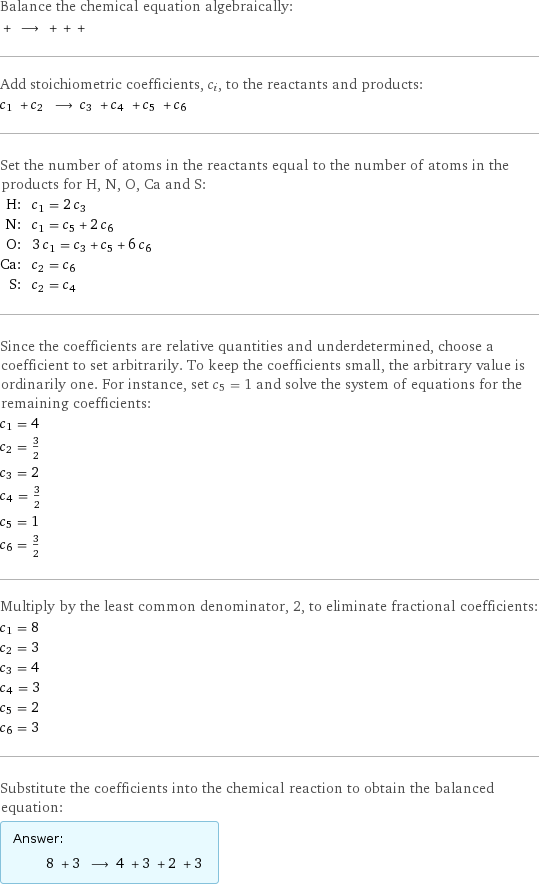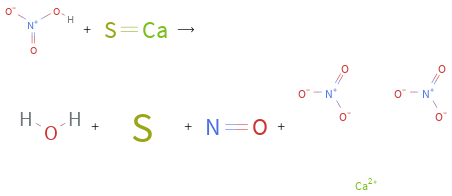Input interpretation

nitric acid + calcium sulfide ⟶ water + mixed sulfur + nitric oxide + calcium nitrate
Balanced equation

Balance the chemical equation algebraically: + ⟶ + + + Add stoichiometric coefficients, c_i, to the reactants and products: c_1 + c_2 ⟶ c_3 + c_4 + c_5 + c_6 Set the number of atoms in the reactants equal to the number of atoms in the products for H, N, O, Ca and S: H: | c_1 = 2 c_3 N: | c_1 = c_5 + 2 c_6 O: | 3 c_1 = c_3 + c_5 + 6 c_6 Ca: | c_2 = c_6 S: | c_2 = c_4 Since the coefficients are relative quantities and underdetermined, choose a coefficient to set arbitrarily. To keep the coefficients small, the arbitrary value is ordinarily one. For instance, set c_5 = 1 and solve the system of equations for the remaining coefficients: c_1 = 4 c_2 = 3/2 c_3 = 2 c_4 = 3/2 c_5 = 1 c_6 = 3/2 Multiply by the least common denominator, 2, to eliminate fractional coefficients: c_1 = 8 c_2 = 3 c_3 = 4 c_4 = 3 c_5 = 2 c_6 = 3 Substitute the coefficients into the chemical reaction to obtain the balanced equation: Answer: | | 8 + 3 ⟶ 4 + 3 + 2 + 3
Structures

+ ⟶ + + +
Names

nitric acid + calcium sulfide ⟶ water + mixed sulfur + nitric oxide + calcium nitrate
Equilibrium constant
![K_c = ([H2O]^4 [S]^3 [NO]^2 [Ca(NO3)2]^3)/([HNO3]^8 [CaS]^3)](../image_source/1eac5f8ddda3a4b0412b8f5a6514904d.png)
K_c = ([H2O]^4 [S]^3 [NO]^2 [Ca(NO3)2]^3)/([HNO3]^8 [CaS]^3)
Rate of reaction
![rate = -1/8 (Δ[HNO3])/(Δt) = -1/3 (Δ[CaS])/(Δt) = 1/4 (Δ[H2O])/(Δt) = 1/3 (Δ[S])/(Δt) = 1/2 (Δ[NO])/(Δt) = 1/3 (Δ[Ca(NO3)2])/(Δt) (assuming constant volume and no accumulation of intermediates or side products)](../image_source/d5b76a713a25d990b732e65cb60a6587.png)
rate = -1/8 (Δ[HNO3])/(Δt) = -1/3 (Δ[CaS])/(Δt) = 1/4 (Δ[H2O])/(Δt) = 1/3 (Δ[S])/(Δt) = 1/2 (Δ[NO])/(Δt) = 1/3 (Δ[Ca(NO3)2])/(Δt) (assuming constant volume and no accumulation of intermediates or side products)
Chemical names and formulas

| nitric acid | calcium sulfide | water | mixed sulfur | nitric oxide | calcium nitrate Hill formula | HNO_3 | CaS | H_2O | S | NO | CaN_2O_6 name | nitric acid | calcium sulfide | water | mixed sulfur | nitric oxide | calcium nitrate IUPAC name | nitric acid | thioxocalcium | water | sulfur | nitric oxide | calcium dinitrate